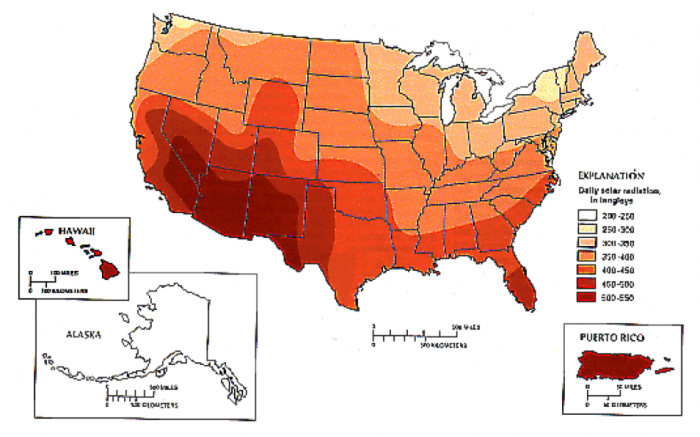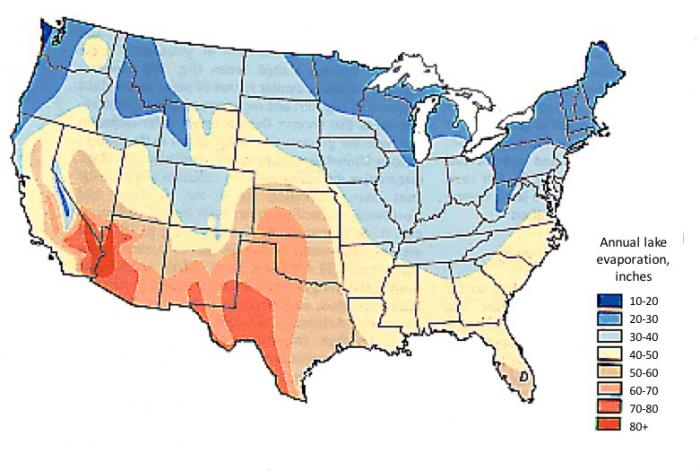5.1.1: Evaporation and Climate
- Page ID
- 48190
In order to understand why growing food uses so much water, we need to explore the process of evaporation. Evaporation is a hydrologic process that we're all quite familiar with, even if you aren't aware of it. Think about hanging clothes out to dry on the clothesline, or blow drying your hair. Both of those involve the movement of water from its liquid form to its vapor or gaseous form that we call water vapor, or in other words, both involve the evaporation of water.
In what weather conditions do your clothes dry faster? A hot, dry, windy day, or a cool, cloudy, rainy day? Why do you use a blow drier to dry your hair? Water evaporates faster if the temperature is higher, the air is dry, and if there's wind. The same is true outside in the natural environment. Evaporation rates are generally higher in hot, dry and windy climates.
The rate at which water evaporates from any surface, whether from a lake's surface or through the stomata on a plant's leaf, is influenced by climatic and weather conditions, which include the solar radiation, temperature, relative humidity and wind (and other meteorological factors). Evaporation rates are higher at higher temperatures because as temperature increases, the amount of energy necessary for evaporation decreases. In sunny, warm weather the loss of water by evaporation is greater than in cloudy and cool weather. Humidity, or water vapor content of the air, also has an effect on evaporation. The lower the relative humidity, the drier the air, and the higher the evaporation rate. The more humid the air, the closer the air is to saturation, and less evaporation can occur. Also, warm air can “hold” a higher concentration of water vapor, so you can think of there being more room for more water vapor to be stored in warmer air than in colder air. Wind moving over a water or land surface can also carry away water vapor, essentially drying the air, which leads to increased evaporation rates. So, sunny, hot, dry, windy conditions produce higher evaporation rates. We will see that the same factors - temperature, humidity, and wind - will affect how much water plants use, which contributes to how much water we use to produce our food!
Evaporation requires a lot of energy and that energy is provided by solar radiation. The maps below (Figure 4.1.1) illustrate the spatial patterns of solar radiation and of annual evaporation rates in the United States. Notice how the amount of solar radiation available for evaporation varies across the US. Solar radiation also varies with the season and weather conditions. Note that annual evaporation rates are given in inches per year. For example, Denver, Colorado in the lake evaporation map is right on the line between the 30-40 inches and 40-50 inches per year of lake evaporation, so let's say 40 inches per year. On average, if you had a swimming pool in Denver, and you never added water and it didn't rain into your pool, the water level in your pool would drop by 40 inches in a year. Explore the maps and answer the questions below.


Figure 4.1.1.: a. Mean daily solar radiation in the United States and Puerto Rico and
b. Mean annual lake evaporation in the conterminous United States, 1946-55. Data not available for Alaska, Hawaii, and Puerto Rico. Source: Data from U.S. Department of Commerce, 1968). From Hanson 1991.
Knowledge Check (flashcards)
Consider how you would answer the questions on the cards below. Click "Turn" to see the correct answer on the reverse side of each card.
Card 1:
Front: How are the patterns on the two maps above (Figure 4.1.1) similar? Which regions experience high solar radiation and which regions experience high evaporation rates?
Back: Generally, the spatial patterns of solar radiation and lake evaporation in the US are similar as high solar radiation drives high evaporation. The southwestern region of the US has both high solar radiation and high evaporation rates.
Card 2:
Front: How are the two maps different? What factors might contribute to the differences?
Back: Two main differences are: The Rocky Mountain region where high elevations lead to cooler temperatures which lowers evaporation rates The southeastern US where high humidity reduces evaporation.
Card 3:
Front: Find your location on the maps. How much solar radiation does your location receive per year, and how much water would evaporate from a lake on average per year?
Back: Find the solar radiation and lake evaporation for your location using the maps below. Note that lake evaporation in Figure 4.1.1b is given in inches per year. Is this value higher than you expected?


